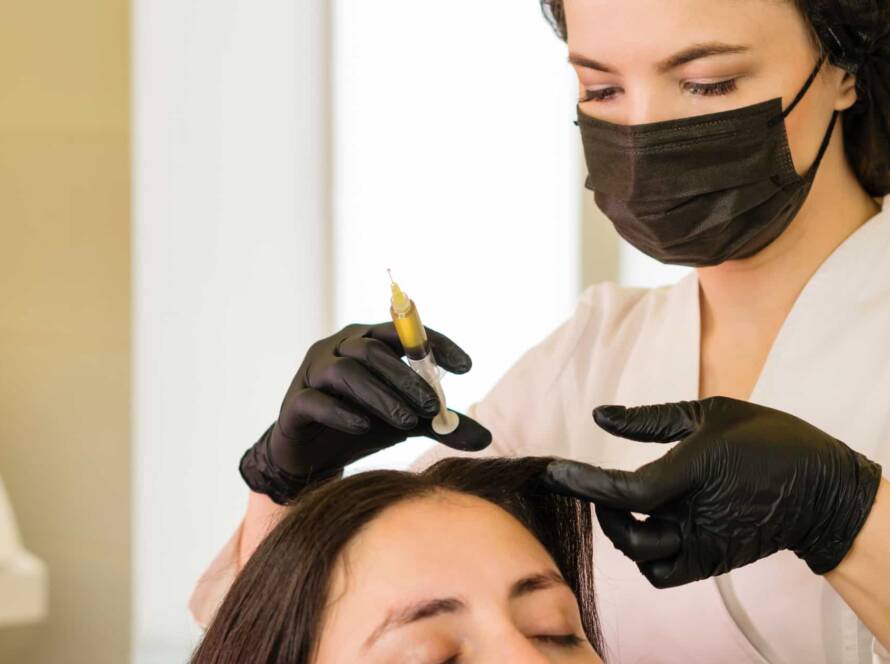Platelet-Rich Plasma (PRP) Therapy : Pros and Cons
Platelet-Rich Plasma (PRP) therapy has emerged as a popular non-surgical treatment in the realm of aesthetic medicine and regenerative medicine. This innovative therapy harnesses the body’s natural healing capabilities to improve skin texture, promote hair growth, and accelerate healing. Despite its growing popularity, PRP therapy has both advantages and limitations. In this blog, we’ll explore the pros and cons of PRP therapy to help you determine whether this treatment might be right for you.
RX REJUVENATE IS THE BEST SKINCARE CLINIC IN DELHI NCR
What is Platelet-Rich Plasma (PRP) Therapy?
PRP therapy involves extracting a small amount of blood from the patient, processing it to concentrate the platelets, and then re-injecting this platelet-rich plasma into targeted areas of the body. Platelets, which are rich in growth factors, play a crucial role in the body’s healing process. PRP therapy is used for various applications, including:
- Skin rejuvenation: Improving skin texture and reducing wrinkles.
- Hair restoration: Stimulating hair growth in cases of androgenetic alopecia or thinning hair.
- Joint and muscle repair: Accelerating recovery from injuries or chronic conditions.
The Pros of PRP Therapy
- Natural Healing ProcessAdvantage: PRP therapy utilizes the body’s own platelets, making it a natural and biocompatible treatment option. Since the plasma is derived from your own blood, the risk of allergic reactions or complications from foreign substances is minimal.
Impact: This natural approach enhances the body’s healing mechanisms and supports tissue regeneration without introducing synthetic or foreign materials.
- Minimal DowntimeAdvantage: The procedure is minimally invasive, often involving only small injections. As a result, patients typically experience minimal downtime and can resume their daily activities shortly after the treatment.
Impact: The quick recovery time is particularly appealing for individuals with busy schedules who want to avoid extended periods of inactivity.
- Versatility of ApplicationsAdvantage: PRP therapy is versatile and can be used for a wide range of conditions, from aesthetic concerns like wrinkles and acne scars to medical issues such as joint pain and hair loss.
Impact: This versatility makes PRP therapy a valuable option for patients seeking multiple benefits from a single treatment approach.
- Long-Lasting ResultsAdvantage: PRP therapy often yields long-lasting results, particularly in terms of skin rejuvenation and hair restoration. While individual results may vary, many patients experience significant improvements that persist over time.
Impact: Long-lasting results reduce the need for frequent treatments and contribute to overall patient satisfaction.
- Safety ProfileAdvantage: Since PRP therapy involves using the patient’s own blood, the risk of infection, allergic reactions, or adverse effects is low. The procedure is generally considered safe when performed by a qualified professional.
Impact: The favorable safety profile enhances patient confidence and minimizes the risks associated with the treatment.
 The Cons of PRP Therapy
The Cons of PRP Therapy
- Results Can Be VariableDisadvantage: The effectiveness of PRP therapy can vary significantly from person to person. Factors such as individual health, the severity of the condition being treated, and the skill of the practitioner can all influence the outcome.
Impact: Patients may not achieve the same level of improvement as others, and some may need multiple treatments to see noticeable results.
- Potential for DiscomfortDisadvantage: While PRP therapy is minimally invasive, some patients may experience discomfort during and after the procedure. This can include mild pain, swelling, or bruising at the injection sites.
Impact: Although discomfort is usually temporary, it may be a concern for individuals with low pain thresholds or those seeking a completely pain-free experience.
- Limited Research on Long-Term EfficacyDisadvantage: While PRP therapy has shown promising results, there is still limited long-term research on its efficacy and safety for some applications. The science behind PRP is evolving, and more studies are needed to establish its long-term benefits.
Impact: The lack of comprehensive long-term data may make some patients hesitant to commit to PRP therapy, especially for conditions where long-term outcomes are uncertain.
- Cost ConsiderationsDisadvantage: PRP therapy can be relatively expensive, and it is often considered a cosmetic or elective procedure. Insurance coverage may be limited or unavailable, requiring patients to pay out-of-pocket for their treatments.
Impact: The cost of PRP therapy can be a barrier for some patients, particularly if multiple sessions are needed to achieve desired results.
 Need for Multiple SessionsDisadvantage: Depending on the condition being treated and the individual’s response, multiple PRP sessions may be required to achieve optimal results. This can increase the overall cost and time commitment for patients.
Need for Multiple SessionsDisadvantage: Depending on the condition being treated and the individual’s response, multiple PRP sessions may be required to achieve optimal results. This can increase the overall cost and time commitment for patients.
Impact: The need for multiple sessions can be a drawback for those seeking a quick or single-treatment solution.
Conclusion
Platelet-Rich Plasma (PRP) therapy offers a range of benefits, including its natural healing properties, minimal downtime, and versatility of applications. However, it also has limitations, such as variable results, potential discomfort, and cost considerations. Understanding both the pros and cons of PRP therapy is essential for making an informed decision about whether this treatment is right for you.
If you’re considering PRP therapy, consult with a qualified healthcare provider or aesthetic professional to discuss your specific needs and expectations. They can help you determine if PRP therapy is suitable for your goals and provide guidance on what to expect from the treatment. By weighing the benefits and drawbacks, you can make a well-informed choice and work towards achieving your desired outcomes. Platelet-Rich Plasma (PRP) Therapy Platelet-Rich Plasma (PRP) Therapy



